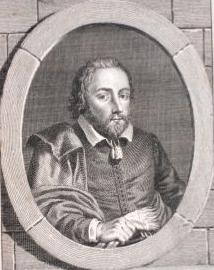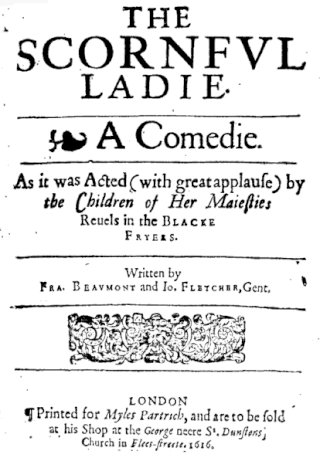Related Research Articles

Philip Massinger was an English dramatist. His finely plotted plays, including A New Way to Pay Old Debts, The City Madam, and The Roman Actor, are noted for their satire and realism, and their political and social themes.
John Webster was an English Jacobean dramatist best known for his tragedies The White Devil and The Duchess of Malfi, which are often seen as masterpieces of the early 17th-century English stage. His life and career overlapped with Shakespeare's.
William Rowley was an English Jacobean dramatist, best known for works written in collaboration with more successful writers. His date of birth is estimated to have been c. 1585; he was buried on 11 February 1626 in the graveyard of St James's, Clerkenwell in north London.
The Night Walker, or The Little Thief is an early seventeenth-century stage play, a comedy written by John Fletcher and later revised by his younger contemporary James Shirley. It was first published in 1640.

A Fair Quarrel is a Jacobean tragicomedy, a collaboration between Thomas Middleton and William Rowley that was first published in 1617.
The Fair Maid of the Inn is an early 17th-century stage play. A comedy in the canon of John Fletcher and his collaborators, it was originally published in the first Beaumont and Fletcher folio of 1647. Uncertainties of the play's date, authorship, and sources make it one of the most widely disputed works in English Renaissance drama.
The Guardian is a Caroline era stage play, a comedy written by Philip Massinger, dating from 1633. "The play in which Massinger comes nearest to urbanity and suavity is The Guardian...."
The Parliament of Love is a late Jacobean era stage play, a comedy written by Philip Massinger. The play was never printed in the seventeenth century, and survived only in a defective manuscript – making it arguably the most problematical work in the Massinger canon.
The Unnatural Combat is a Jacobean era stage play, a tragedy written by Philip Massinger, and first published in 1639.
The Honest Man's Fortune is a Jacobean era stage play, a tragicomedy written by Nathan Field, John Fletcher, and Philip Massinger. It was apparently the earliest of the works produced by this trio of writers, the others being The Queen of Corinth and The Knight of Malta.
The Little French Lawyer is a Jacobean era stage play, a comedy written by John Fletcher and Philip Massinger. It was initially published in the first Beaumont and Fletcher folio of 1647.
The Lovers' Progress is an early seventeenth-century stage play, a tragicomedy written by John Fletcher and Philip Massinger. As its multiple titles indicate, the play has a complex history and has been a focus of controversy among scholars and critics.

The Maid in the Mill is a late Jacobean era stage play, a comedy written by John Fletcher and William Rowley. It was initially published in the first Beaumont and Fletcher folio of 1647.
The Devil's Law Case is a Jacobean era stage play, a tragicomedy written by John Webster, and first published in 1623.
Love's Cure, or The Martial Maid is an early seventeenth-century stage play, a comedy in the canon of John Fletcher and his collaborators. First published in the Beaumont and Fletcher folio of 1647, it is the subject of broad dispute and uncertainty among scholars. In the words of Gerald Eades Bentley, "nearly everything about the play is in a state of confusion...."
Thierry and Theodoret is a Jacobean era stage play, a tragedy in the canon of John Fletcher and his collaborators that was first published in 1621. It is one of the problematic plays of Fletcher's oeuvre; as with Love's Cure, there are significant uncertainties about the date and authorship of Thierry and Theodoret.

The Scornful Lady is a Jacobean era stage play, a comedy written by Francis Beaumont and John Fletcher, and first published in 1616, the year of Beaumont's death. It was one of the pair's most popular, often revived, and frequently reprinted works.
The Thracian Wonder is a stage play of English Renaissance drama, a work that constitutes a long-standing and persistent problem for scholars and historians of the subject.
A cuckquean is the wife of an adulterous husband, and the gender-opposite of a cuckold. In evolutionary biology, the term is also applied to females who are investing parental effort in offspring that are not genetically their own. Similar prying within a family is called wittoldry. The term is derived from Early Modern English dating back to AD 1562 and is composed of the terms cuck "someone whose partner is unfaithful" and quean "disreputable woman".
The Dumb Knight, The Dumbe Knight: A Historical Comedy, or The Dumbe Knight: A Pleasant Comedy, written by Lewis Machin and Gervase Markham in roughly 1601 was acted by the Children of the King's Revels likely in the Whitefriars Theatre, which was the acting group's primarily venue. The play was first published in 1608 by Nicholas Okes and were sold at John Bache's in Popes-head Palace near the Royal Exchange in London. The play takes place in Sicily and the main plot focus on the characters around the King of Cyprus, who has just conquered Sicily. A strange love between Philocles and Mariana form which nearly has Mariana executed. Out of revenge for the dishonour towards his sister Duke of Epire plans to remove Philocles and the King and make himself king promising that they “both shall tumble down”. While the subplot of Prate and Alphonso provide comic foolery and clash with the main plot at the end of the play. Although the title of the play is The Dumb Knight, Philocles, the “dumb knight” and the second in command to the King of Cyprus, is only mute for a couple of scenes in Act Two and Three. Philocles has an active voice throughout the play and his spell of speechlessness is used to advance the main plot but is not the plots focus.
References
- ↑ Terence P. Logan and Denzell S. Smith, eds., The Popular School: A Survey and Bibliography of Recent Studies in English Renaissance Drama, Lincoln, NE, University of Nebraska Press, 1975; p. 96.
- ↑ Alfred Harbage, "Elizabethan:Restoration Palimpsests," Modern Language Review Vol. 35 No. 3 (July 1940), pp. 287–319; see p. 289.
- ↑ Elmer Edgar Stioll, John Webster: The Periods of His Work as Determined by His Relations to the Drama of His Day, Boston, Alfred Mudge, 1905; pp. 34–43.
- ↑ Edmund Goose, "John Webster," Fraser's Magazine, May 1874.
- ↑ Henry David Gray, "A Cure for a Cuckold by Heywood, Rowley, and Webster," Modern Language Review 22 (1927); pp. 389–97.
- ↑ Logan and Smith, p. 96. Lucas, The Complete Works of John Webster, 1927, Vol.3, pp. 10–18. "Archived copy" (PDF). Archived from the original (PDF) on 20 August 2011. Retrieved 5 April 2011.
{{cite web}}: CS1 maint: archived copy as title (link) - ↑ Rupert Brooke, John Webster and the Elizabethan Drama, New York, John Lane, 1916; pp. 261–74.